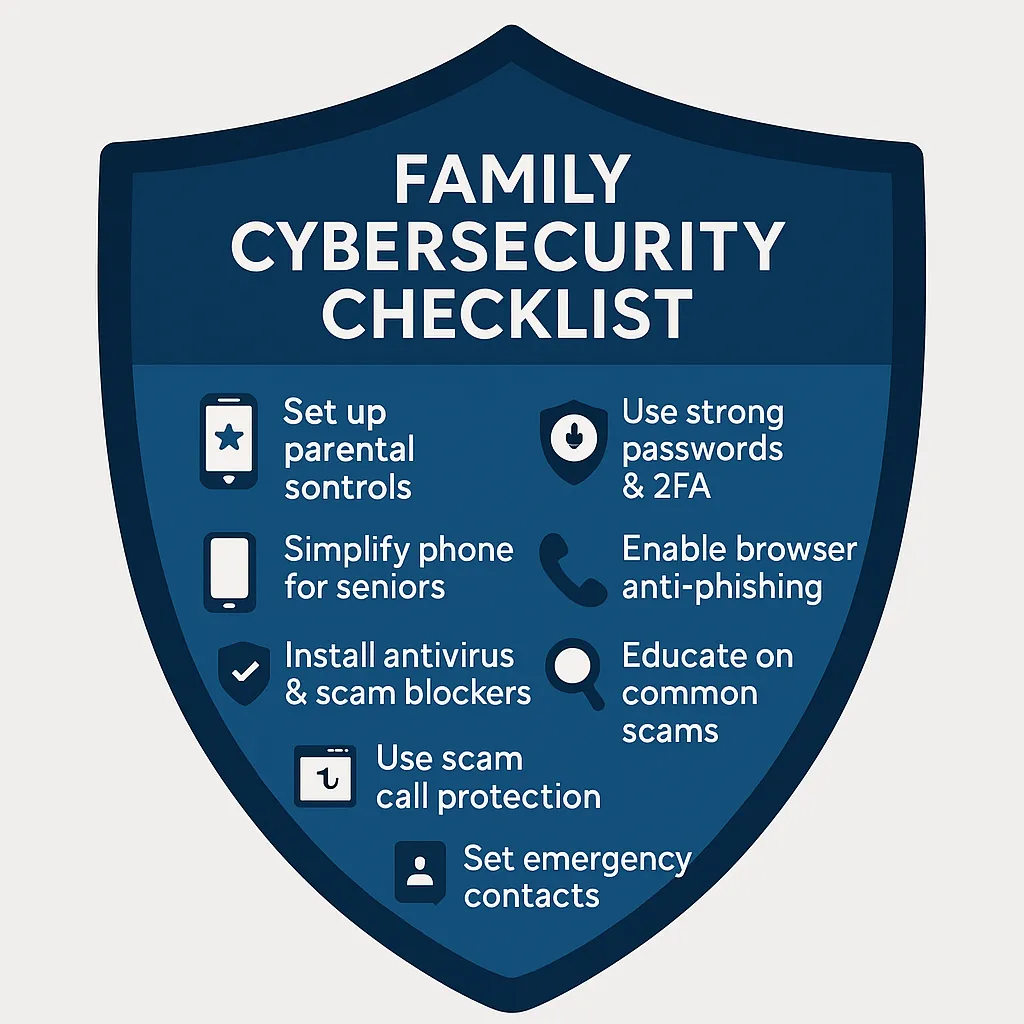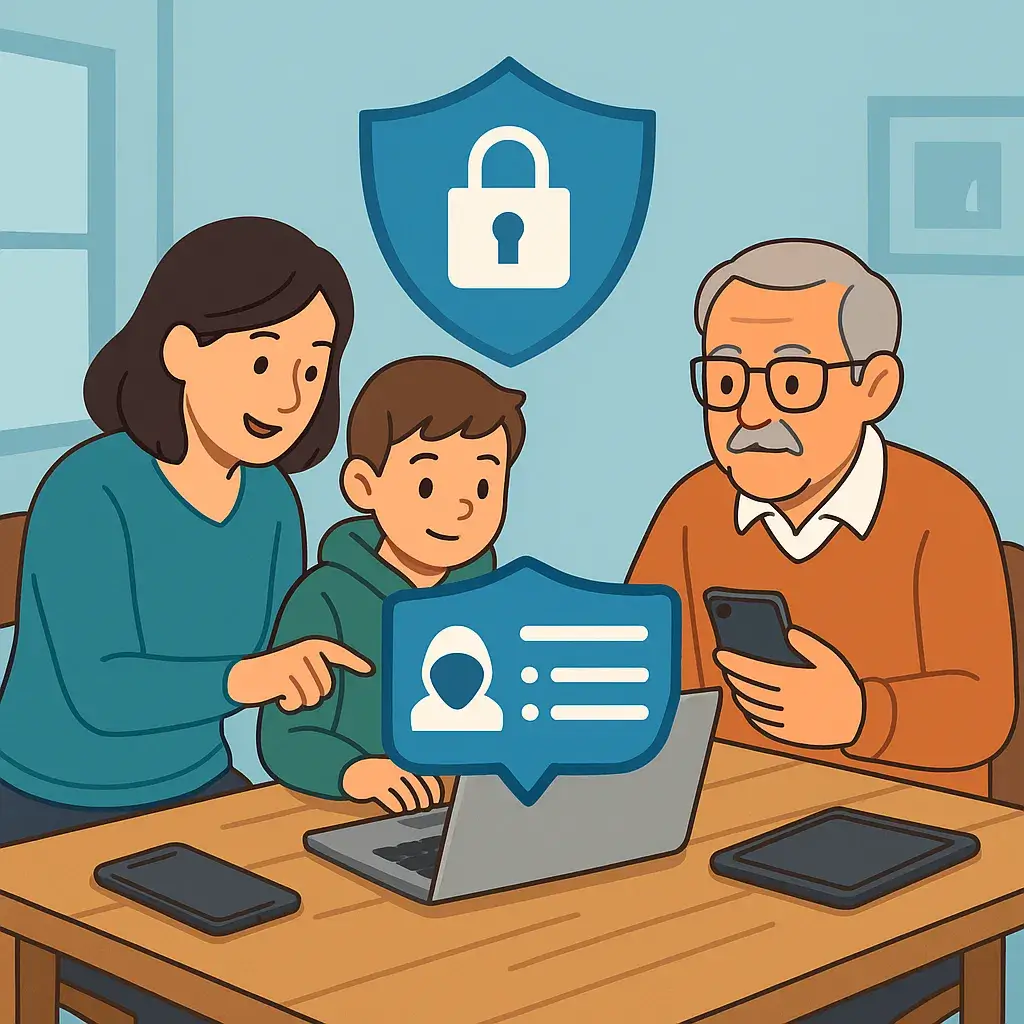🛡️ The Internet Can Be Wonderful — or Dangerous. Here’s How to Keep Loved Ones Safe.
🚩 Why Children and Seniors Are Primary Targets
✔️ Children:
- Trust strangers easily.
- Lack understanding of online risks.
- Click on anything colorful, fun, or attention-grabbing.
- Vulnerable to predators, scammers, and inappropriate content.
✔️ Seniors:
- Less tech-savvy.
- More trusting, especially toward authority figures.
- Often targets of phishing, scams, fraud, identity theft.
- Struggle with complex passwords, 2FA (Two-Factor Authentication), or security settings.
→ “According to the FBI’s Internet Crime Complaint Center (IC3) 2023 report, seniors lost over $3.1 billion to cybercrime — a 22% increase from the previous year.”
→ The same report highlights that cyberbullying and online exploitation among minors have doubled in the past three years.
🏴☠️ Common Threats Facing Children and Seniors
🔥 Children Face:
- Cyberbullying — harassment on social media, games, chats.
- Online predators — posing as peers, grooming for exploitation.
- Inappropriate content — violence, pornography, drugs.
- Scams in games/apps — fake giveaways, in-app fraud.
- Malware disguised as games, mods, cheats.
🔥 Seniors Face:
- Phishing emails and SMS (Smishing) — fake bank, government, or tech support messages.
- Tech support scams — “Microsoft” or “Apple” calls claiming viruses.
- Romance scams — fake relationships leading to financial fraud.
- Investment scams — fake cryptocurrency, stock opportunities.
- Identity theft — using leaked personal data for fraud.
🔒 Step-By-Step Guide — How to Protect Children Online
✅ ASCII Diagram — Parental Control Layering
+----------------------+
| Internet |
+----------+-----------+
|
[Router-Level Filters]
|
+------------+------------+
| |
[Device Parental Controls] [App Controls]
| |
[Child's Phone] [Games, Social Media, etc.]
🔹 Shows how different layers (router → device → app) form a defense-in-depth model for protecting children.
✅ 1. Set Up Parental Controls on All Devices
✔️ Google Family Link (Android)
✔️ Apple Screen Time (iOS, iPad, Mac)
✔️ Windows and Xbox parental controls
✔️ Router-level content filters (Netgear Armor, ASUS AiProtection, etc.)
✅ 2. Use Safe Browsers and Search Engines
✔️ Kiddle, KidzSearch, Google SafeSearch
✔️ Block adult websites and harmful content at the DNS (Domain Name System) level with CleanBrowsing, AdGuard DNS, NextDNS.
✅ 3. Teach Digital Rules Early
→ Example rules:
✔️ Never share real name, address, school, or phone number.
✔️ No private chats with strangers.
✔️ No sharing photos without parent approval.
✔️ Ask before downloading anything.
✅ 4. Monitor Apps, Games, and Social Media
✔️ Check permissions: camera, microphone, location.
✔️ Review chat functions in games like Roblox, Fortnite, Minecraft.
✔️ Disable chats where possible.
✔️ Set screen time limits.
🧠 Case Study: Malicious Game App
Scenario: A 10-year-old child downloaded a “free skin mod” app for Minecraft from an unofficial app store. The app promised cool new character designs but secretly installed spyware on the device.
What It Did:
- Logged keystrokes (including saved passwords)
- Captured screen activity during gameplay and messaging
- Sent data to an external command-and-control server
Outcome:
- The child’s online accounts were compromised.
- Parents only discovered it after strange purchases appeared on their linked Google account.
Lesson Learned:
→ This incident reinforces why strict app monitoring, permissions control, and using only trusted sources are essential.
“Even a seemingly innocent game add-on can turn into a digital Trojan horse,” warns the Cybersecurity and Infrastructure Security Agency (CISA).
✅ 5. Open Communication — No Shame Culture
→ Make sure kids feel safe telling you if:
- They get weird messages.
- Someone asks for photos.
- They’re being bullied.
✅ 6. Use Monitoring Tools (Optional)
✔️ Bark, Qustodio, Norton Family, Kaspersky Safe Kids.
→ Monitor activity, filter websites, and set usage limits.
✔️ Balance privacy and safety — explain why monitoring exists.
🔒 Step-By-Step Guide — How to Protect Seniors Online
📊 Table — Scam Feature Comparison (For Seniors)
| Feature | Real Emergency Call | Common Scam Call |
|---|---|---|
| Caller Verification | Family member, known voice | Unknown voice, poor connection |
| Emotional Urgency | Low to moderate | Very high — “Jail now!” |
| Request for Secrecy | Rare | Frequent — “Don’t tell mom/dad!” |
| Method of Payment | Standard banking | Gift cards, wire transfer, crypto |
| Caller ID | Matches known number | Often spoofed or unknown |
✅ 1. Simplify Devices for Safety
✔️ Organize the home screen: only essential apps.
✔️ Turn off unused features (Bluetooth, NFC, location when not needed).
✔️ Install automatic updates for OS and apps.
✅ 2. Enable Strong Security Settings
✔️ Set up biometric login (fingerprint, Face ID) where possible.
✔️ Use strong, memorable passwords — assisted by a password manager like Bitwarden, Dashlane, Proton Pass.
✔️ Enable Two-Factor Authentication (2FA) — preferably with authenticator apps.
✅ 3. Use Scam Protection Tools
✔️ Enable spam filters in email.
✔️ Enable scam call protection (Truecaller, Hiya, or carrier-based blockers).
✔️ Install antivirus/antimalware: Malwarebytes, Bitdefender, Norton.
✔️ Use browsers with anti-phishing protection: Brave, Firefox, Edge, Safari.
✅ 4. Educate on Common Scams
✔️ Teach to recognize:
- Fake emails from banks, IRS, Microsoft.
- Never click unknown links or attachments.
- Ignore calls claiming “your account is locked.”
- “If it sounds too good to be true — it is.”
✅ 5. Financial Security First
✔️ Enable bank notifications for all transactions.
✔️ Use credit instead of debit when possible (stronger fraud protection).
✔️ Teach about freezing credit with Experian, Equifax, TransUnion (U.S.) or local equivalents.
✔️ “According to CISA (Cybersecurity and Infrastructure Security Agency) 2024, financial fraud against seniors is the fastest-growing category of cybercrime.”
✅ 6. Emergency Contacts on Speed Dial
✔️ Add family tech support numbers.
✔️ Include fraud reporting numbers from banks and phone carriers.
→ Make it easy for them to get help fast.
🚫 Common Mistakes Families Make
- ❌ Believing “this won’t happen to me or my family.”
- ❌ No parental controls on devices.
- ❌ Assuming seniors understand digital threats.
- ❌ No backup or recovery plans for accounts.
- ❌ Ignoring scam warnings as “paranoid.”
🧩 Table — Common Threats to Children vs Seniors
| Threat Type | Children | Seniors |
|---|---|---|
| Phishing | In games/apps | Via email/SMS/phone |
| Malware | Game mods, clickbait | Email attachments, fake downloads |
| Social Engineering | Online grooming | Romance or tech support scams |
| Identity Theft | Public profiles | Leaked personal info or SSNs |
| Inappropriate Content | Via unfiltered searches | Pop-ups or redirected links |
🏴☠️ Real-World Example — The Grandparent Scam
A scammer calls pretending to be the victim’s grandson: “Grandma, I’ve been arrested. Please send $5,000.”
✔️ Common tactic involves urgency, secrecy, and emotional manipulation.
✔️ Thousands fall victim every year, according to the Federal Trade Commission (FTC).
🚀 Family Cybersecurity Checklist
- 🔲 Set up parental controls (for kids).
- 🔲 Simplify phones for seniors.
- 🔲 Install antivirus and scam blockers.
- 🔲 Use strong passwords and 2FA on all accounts.
- 🔲 Enable browser anti-phishing tools.
- 🔲 Use scam call protection.
- 🔲 Educate on common scams.
- 🔲 Set emergency contacts for fast help.
- 🔲 Discuss online safety regularly as a family.

🏆 Final Thoughts
The Internet is both a playground and a battlefield.
Protecting the most vulnerable — children and seniors — isn’t just about installing apps. It’s about education, vigilance, open conversations, and healthy digital habits.
→ Cybersecurity is a family skill. The earlier you build it — the safer everyone becomes.
✅ Final Note
Sources referenced in this article:
- FBI Internet Crime Complaint Center (IC3) Report 2023
- Cybersecurity and Infrastructure Security Agency (CISA) 2024
- Federal Trade Commission (FTC) Scam Alerts 2024
- Verizon Data Breach Investigations Report (DBIR) 2023
- Electronic Frontier Foundation (EFF) Privacy Guide 2024
📖 Glossary — Key Terms
- 2FA (Two-Factor Authentication) — A security method requiring a password plus a second form of identity (e.g., a code or hardware key).
- CISA (Cybersecurity and Infrastructure Security Agency) — U.S. government agency focused on cybersecurity.
- DNS (Domain Name System) — The system that translates domain names into IP addresses.
- EFF (Electronic Frontier Foundation) — Non-profit defending digital privacy.
- FTC (Federal Trade Commission) — U.S. government agency protecting consumers.
- IC3 (Internet Crime Complaint Center) — FBI unit for reporting cybercrime.
- NFC (Near-Field Communication) — Wireless data exchange over short distances (like contactless payments).
- Phishing — Fraudulent attempts to steal personal info via fake emails or websites.
- SIM Swapping — Stealing a phone number to access accounts.
- Smishing — Phishing through SMS messages.
